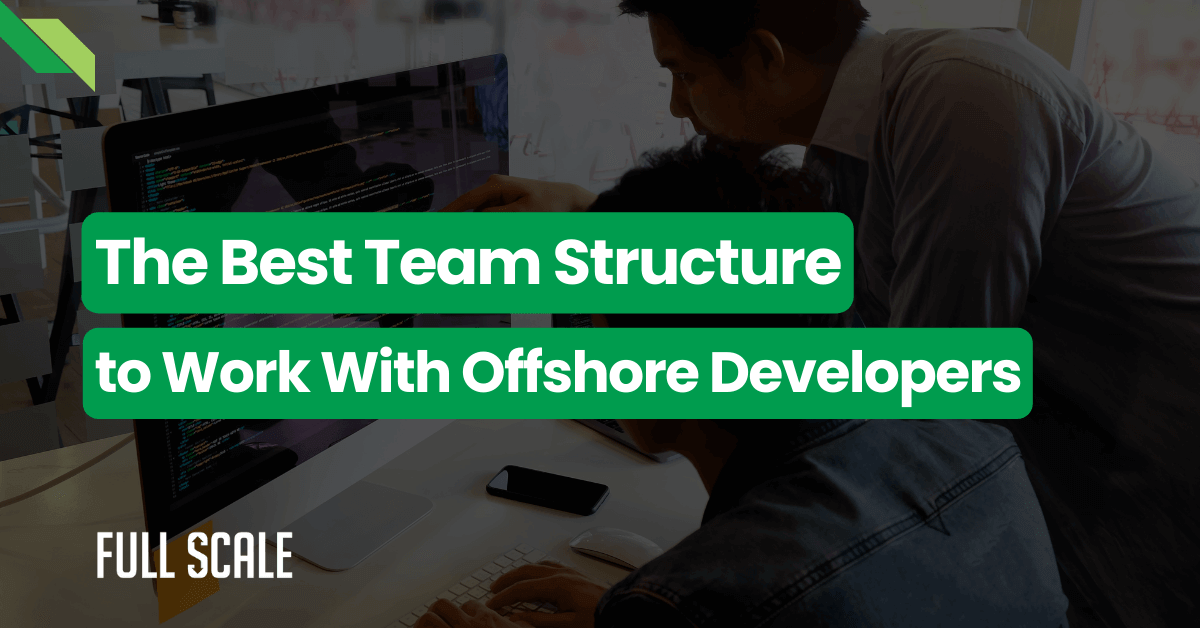The software development landscape faces unprecedented cost pressures in 2025. Offshore development costs have become a critical consideration for technical leaders worldwide. Rising local salaries and talent shortages force companies to explore distributed team models.
Recent data reveals compelling trends in global development economics:
- U.S. developer salaries increased 12% year-over-year, reaching $155,000 average (Stack Overflow Developer Survey 2024)
- 73% of companies now employ distributed development teams (Gartner Tech Workforce Report 2024)
- Strategic offshore partnerships reduce development costs by 40-60% while maintaining quality standards
Technical leaders must navigate complex decisions about team composition and location. Local developer hiring costs continue climbing in major tech hubs globally. Smart companies leverage nearshore vs offshore development options to optimize budgets effectively.
Key considerations for distributed team decisions include:
- Total cost of ownership beyond hourly rates
- Productivity differences across geographic regions
- Communication and collaboration requirements
- Quality assurance and code standards
- Time zone alignment needs
This comprehensive software development team cost comparison provides actionable insights for CTOs and VPs of Engineering. We analyze real costs, hidden expenses, and ROI across different team models.
Current Market Overview on Offshore Development Costs
The global development pricing landscape has shifted dramatically since 2023. Post-pandemic normalization created new standards for remote collaboration worldwide. Currency fluctuations and regional economic changes impact pricing models significantly.
Regional Rate Evolution
Offshore development costs reflect several key market dynamics:
- Southeast Asian rates increased 8-12% annually for senior developers
- Eastern European developers maintain competitive pricing despite regional pressures
- Latin American nearshore markets stabilized after two years of growth
- Specialized skills command 30-50% premiums across all regions
| Region | 2023 Avg Rate | 2025 Avg Rate | % Change | Key Factors |
| India | $22-35/hour | $25-40/hour | +14% | Rupee strength, skill demand |
| Philippines | $18-28/hour | $20-32/hour | +11% | Infrastructure improvements |
| Eastern Europe | $35-55/hour | $38-60/hour | +9% | Political stability concerns |
| Latin America | $30-45/hour | $32-48/hour | +7% | Market maturation |
Technology Stack Premiums
Specialized technologies command significant rate premiums globally. AI/ML expertise costs 40% more than general development skills. Cloud architecture specialists see 35% premiums across all geographic regions.
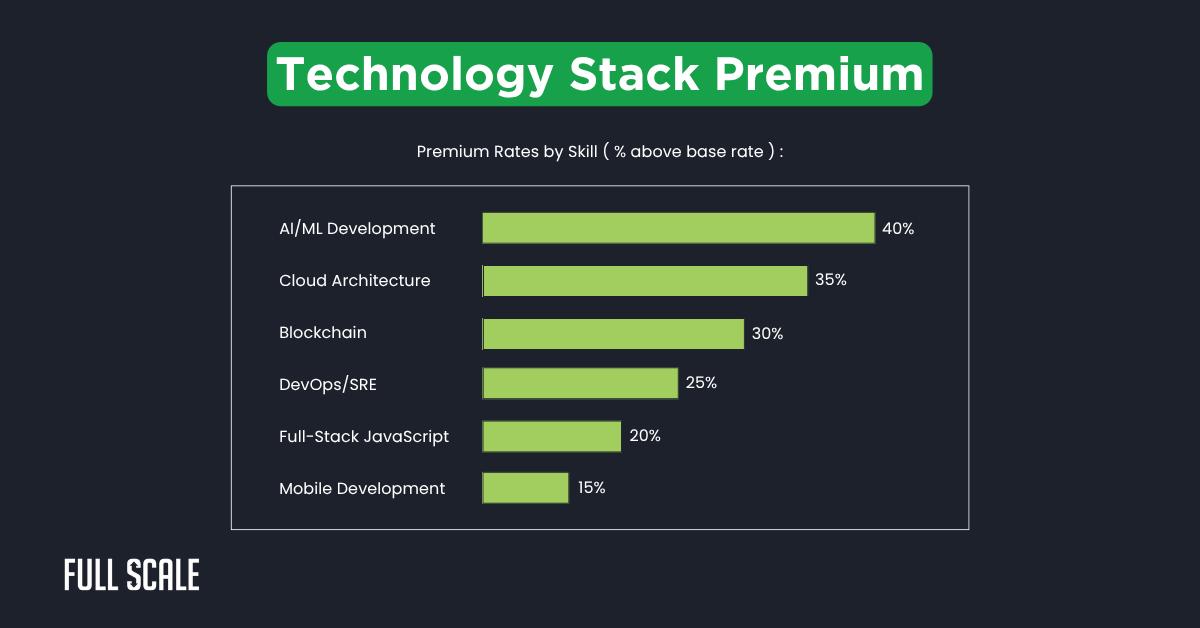
True Cost Analysis: Local vs. Nearshore vs Offshore
Understanding total costs requires looking beyond hourly rates alone. Local developer hiring costs include numerous hidden expenses that are often overlooked. Comprehensive analysis reveals the true economics of each model.
Complete Cost Breakdown
| Cost Component | Local Teams | Nearshore Teams | Offshore Teams |
| Direct Costs | |||
| Base Salary/Rate | $120,000-180,000/year | $65,000-95,000/year | $40,000-65,000/year |
| Benefits (% of base) | 25-30% | 15-20% | 10-15% |
| Recruitment Cost | $20,000-40,000 | $5,000-10,000 | $2,000-5,000 |
| Indirect Costs | |||
| Office/Infrastructure | $8,000-12,000/year | $2,000-4,000/year | $1,500-3,000/year |
| Management Overhead | 15-20% | 20-25% | 25-30% |
| Training/Development | $3,000-5,000/year | $1,500-2,500/year | $1,000-2,000/year |
| Hidden Costs | |||
| Communication Tools | $1,200/year | $2,400/year | $3,600/year |
| Time Zone Coordination | Minimal | 5-10% productivity | 15-20% productivity |
| Knowledge Transfer | 5% effort | 10% effort | 15% effort |
| Total Annual Cost | $180,000-280,000 | $95,000-145,000 | $65,000-100,000 |
Productivity-Adjusted Comparisons
Raw cost comparisons miss crucial productivity differences between team types. Effective hourly rates must account for actual output variations. When evaluating offshore development costs, productivity adjustments reveal true economics.

Key productivity factors include:
- Communication efficiency and language barriers
- Time zone overlap for collaboration
- Domain knowledge and business context
- Technical infrastructure and tool access
Nearshore vs. Offshore Development: Strategic Comparison
The choice between nearshore vs. offshore development impacts project success significantly. Each model offers distinct advantages for different project types. Understanding these differences enables optimal team composition decisions.
Comprehensive Comparison Matrix
| Factor | Nearshore Development | Offshore Development |
| Cost Savings | 35-50% vs local | 50-70% vs local |
| Time Zone Overlap | 4-6 hours | 1-3 hours |
| Cultural Alignment | High (80-90%) | Moderate (60-70%) |
| Language Proficiency | Excellent | Good to Excellent |
| Travel Costs | $2,000-4,000/trip | $4,000-8,000/trip |
| Ideal For | Agile development, Daily collaboration | Maintenance, Defined projects |
| Typical Locations | Mexico, Costa Rica, Argentina | India, Philippines, Vietnam |
| Average Team Size | 5-20 developers | 10-50+ developers |
Decision Framework
Smart allocation of development resources depends on project characteristics and business priorities. Understanding offshore development costs helps inform strategic decisions. Companies must balance multiple factors when choosing team locations.
Choose nearshore development when:
- Real-time collaboration is critical
- Complex requirements need frequent clarification
- Cultural alignment impacts user experience
- Budget allows for moderate cost savings
Choose offshore development when:
- Well-defined projects with clear specifications
- Maximum cost savings are the priority
- 24-hour development cycles benefit the timeline
- Large team scaling is required
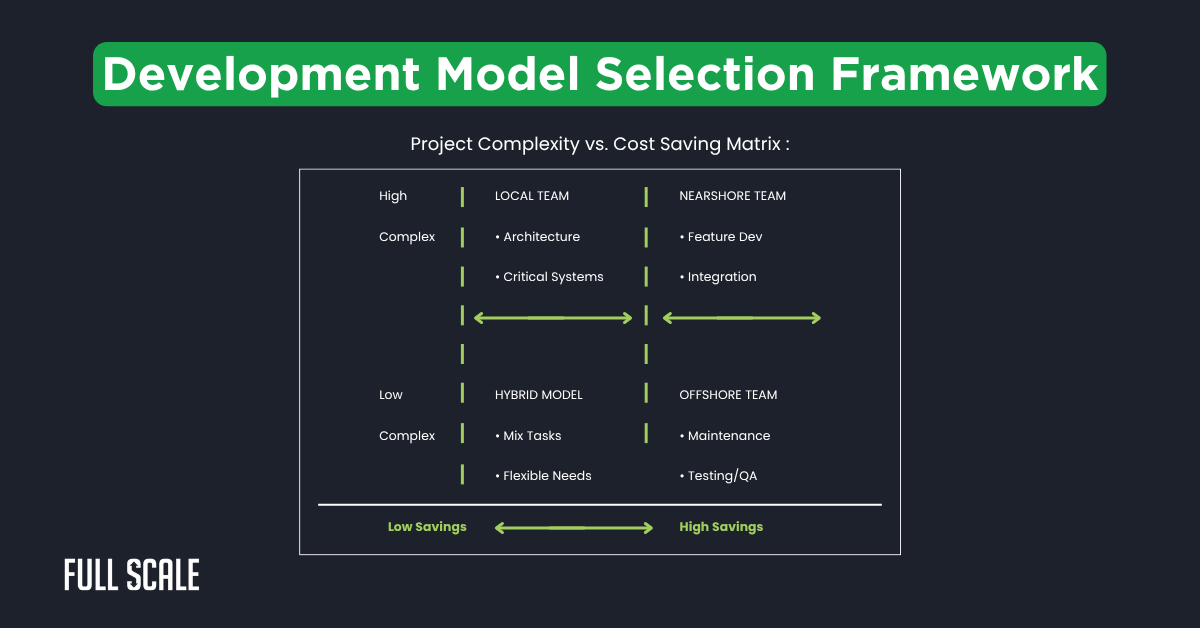
Building Optimal Hybrid Teams
Strategic work distribution across team types maximizes both efficiency and cost-effectiveness. Successful companies blend local, nearshore, and offshore talent purposefully. Software development team cost comparison shows hybrid models deliver superior ROI.
Recommended Team Composition Models
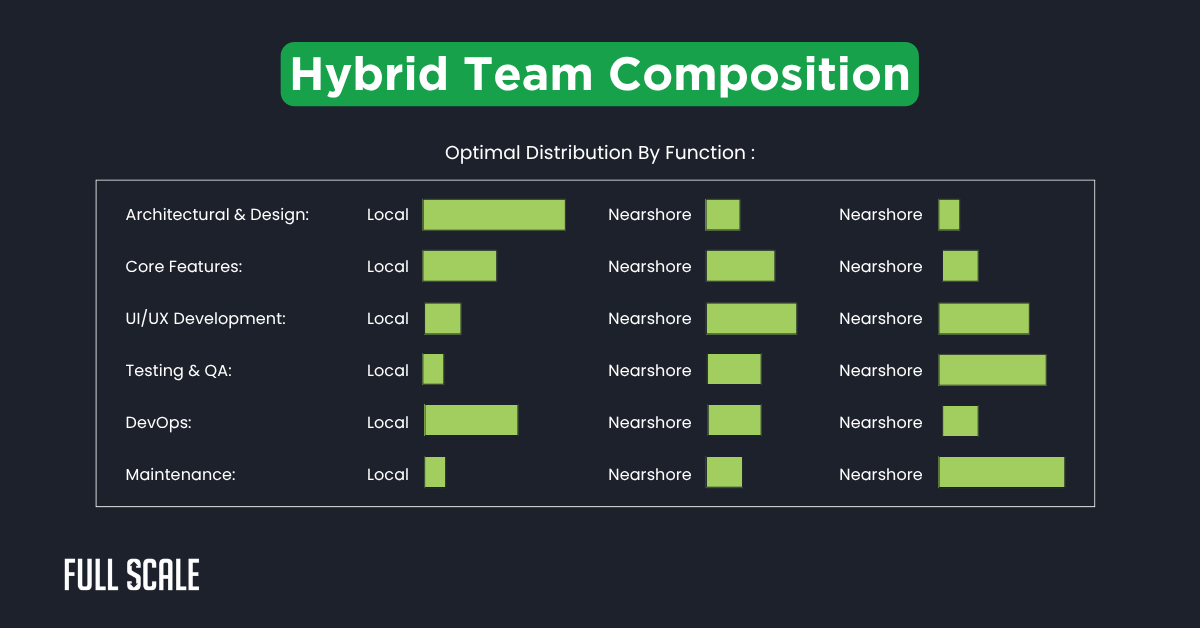
Cost Impact of Different Models
| Team Model | Monthly Cost | Velocity | Cost per Feature |
| 100% Local | $120,000 | 40 points | $3,000 |
| 70% Local, 30% Nearshore | $96,000 | 42 points | $2,285 |
| 40% Local, 30% Nearshore, 30% Offshore | $72,000 | 38 points | $1,895 |
| 30% Local, 30% Nearshore, 40% Offshore | $66,000 | 36 points | $1,833 |
Key success factors for hybrid teams:
- Clear role definition and responsibility allocation
- Robust communication frameworks and tools
- Strong technical leadership across all locations
- Comprehensive documentation standards
- Regular knowledge sharing sessions
Implementation Strategy for 2025
Transitioning to distributed teams requires systematic planning and execution. Companies report 3-6 months for successful team integration. Strategic approaches minimize risk while maximizing cost benefits quickly. Current offshore development costs in 2025 make the investment worthwhile for most organizations.
Phased Implementation Roadmap
Successful distributed team implementation follows a proven three-phase approach. Each phase builds upon previous learnings to minimize risk. Companies typically achieve full integration within six months.
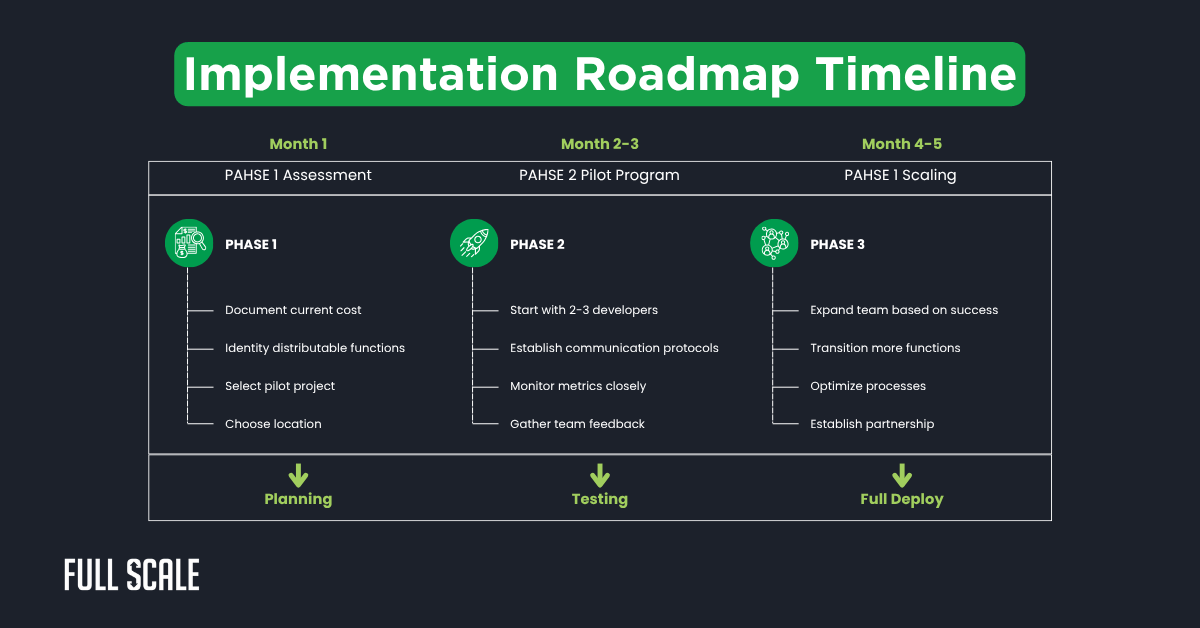
Risk Mitigation Checklist
Critical risks and mitigation strategies:
- Communication gaps: Implement daily standups and clear documentation
- Quality concerns: Establish code review processes and automated testing
- Knowledge silos: Create comprehensive documentation and rotation programs
- Cultural differences: Invest in team building and cultural training
- Security risks: Implement VPNs and access controls
Future Outlook: 2025-2027 Trends
Offshore development costs will continue evolving through technological advances. AI tools reduce productivity gaps between geographic regions significantly. Emerging markets offer new opportunities for cost optimization strategies.
Emerging Trends Impact
| Trend | Impact on Costs | Timeline | Preparation Strategy |
| AI-Assisted Coding | -20% to -30% rates | 12-18 months | Invest in AI tools training |
| African Tech Hubs | New low-cost options | 18-24 months | Build early partnerships |
| Outcome-Based Pricing | Risk-sharing models | 6-12 months | Define clear metrics |
| Virtual Collaboration | Reduced travel needs | Immediate | Upgrade infrastructure |
Key predictions from industry leaders:
- 70% of development will be distributed by 2027
- Quality differences between regions will disappear
- Specialized skills will command a premium regardless of location
- Hybrid models will become the industry standard
- Offshore development costs in 2025 will stabilize as markets mature
Transform Your Development Economics with Full Scale
Building cost-optimized development teams requires expertise in global talent management. Local developer hiring costs continue rising while quality offshore options expand.
At Full Scale, we help companies reduce development costs by 40-60% without sacrificing quality. Our proven approach to building distributed teams delivers measurable ROI within months.
Why Full Scale for Your Distributed Team Strategy?
- Proven Global Network: Access pre-vetted developers across premier offshore and nearshore locations. Our screening process ensures that only the top 3% join your team. Technical assessments validate skills before the first introduction.
- Flexible Engagement Models: Scale teams instantly based on project needs and budget. Choose dedicated teams or staff augmentation without restrictive contracts. Adjust team composition as requirements evolve.
- Seamless Integration Process: Our methodology ensures productive teams within two weeks. Communication frameworks come pre-configured for immediate collaboration. Cultural training eliminates common friction points.
- Transparent All-Inclusive Pricing: Know exactly what you pay with no hidden fees. Infrastructure, management, and support services are included completely. Compare total costs confidently against any alternative.
Don’t let rising local developer hiring costs limit your growth potential. Schedule a consultation to explore how Full Scale optimizes your development economics.
Hire Full Scale to Optimize Your Development Cost
FAQs: Offshore Development Costs in 2025
What are the typical offshore development costs in 2025 for different skill levels?
Offshore development costs in 2025 vary significantly by region and expertise level:
- Junior developers (0-2 years): $15-25/hour in India, $20-30/hour in Eastern Europe
- Mid-level developers (3-5 years): $25-40/hour in Asia, $35-50/hour in Latin America
- Senior developers (5+ years): $40-65/hour in India, $50-70/hour in nearshore locations
- Specialized skills (AI/ML, blockchain): Add 30-50% premium to base rates
How do nearshore vs offshore development models differ in 2025?
Key differences in nearshore vs offshore development include:
Nearshore advantages:
- 4-6 hour time zone overlap
- Easier travel (2-4 hour flights)
- Cultural alignment (80-90%)
- Real-time collaboration
Offshore advantages:
- Maximum cost savings (50-70%)
- Larger talent pools
- 24-hour development cycles
- Established infrastructure
What hidden costs affect software development team cost comparison?
Beyond hourly rates, software development team cost comparison must include:
- Communication overhead: 15-20% productivity loss for offshore teams
- Management time: An additional 25-30% oversight for distributed teams
- Infrastructure costs: $200-300/developer monthly for tools and security
- Knowledge transfer: 10-15% of project effort for documentation
- Quality assurance: Extra 20% resources for code review processes
How long does it take to see ROI from offshore teams?
Most companies report positive ROI within 3-6 months when considering offshore development costs in 2025:
- Month 1-2: Initial setup and onboarding (-20% productivity)
- Month 3-4: Team integration and process optimization (60% productivity)
- Month 5-6: Full productivity achievement (85% of local team output)
- Month 6+: Consistent 40-60% cost savings realized
What factors determine local developer hiring costs in 2025?
Local developer hiring costs depend on multiple factors:
- Geographic location: Silicon Valley is 40% higher than the national average
- Technology stack: Specialized skills add $20,000-40,000 to base salary
- Company size: Startups pay 10-15% less than enterprises
- Benefits package: Adds 25-30% to base compensation
- Recruitment fees: $15,000-40,000 per successful hire
How does Full Scale help optimize offshore development costs in 2025?
Full Scale reduces offshore development costs in 2025 through:
- Pre-vetted talent: Skip expensive recruitment cycles
- Flexible contracts: Scale teams up/down without penalties
- All-inclusive pricing: No hidden infrastructure or management fees
- Proven processes: Achieve 85% productivity within 30 days
- Risk mitigation: Replace underperforming developers at no cost
Contact Full Scale for a custom cost analysis based on your specific needs.

Matt Watson is a serial tech entrepreneur who has started four companies and had a nine-figure exit. He was the founder and CTO of VinSolutions, the #1 CRM software used in today’s automotive industry. He has over twenty years of experience working as a tech CTO and building cutting-edge SaaS solutions.
As the CEO of Full Scale, he has helped over 100 tech companies build their software services and development teams. Full Scale specializes in helping tech companies grow by augmenting their in-house teams with software development talent from the Philippines.
Matt hosts Startup Hustle, a top podcast about entrepreneurship with over 6 million downloads. He has a wealth of knowledge about startups and business from his personal experience and from interviewing hundreds of other entrepreneurs.


